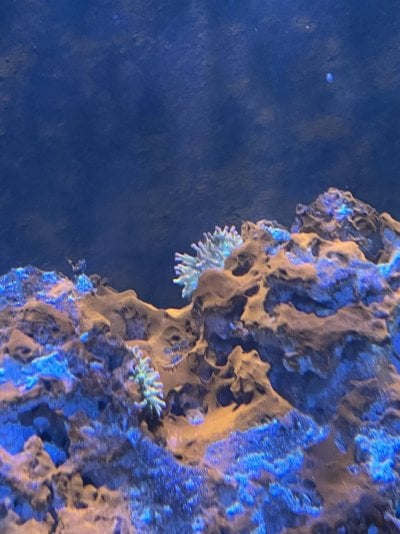My tank is covered in cyanobacteria and I've been having some trouble trying to figure out how to beat it. I would like to stay away from using chemi-clean as much as possible. I am waiting to get my clean-up crew through quarantine so that I can add them to the tank and they can help out a little bit and I've also added some pods in hopes that they might help a little bit too, however I understand if it will just take some more time in order for them to start out-competing the cyano. Since the cyano outbreak I've been using a small powerhead to blast the rocks during water changes and have slightly increased the amount of water being changed from 25 to 35 gallons. I believe that my issue is with flow as I have only been using 2 MP40's on either side at about 60%, since the outbreak I've increased the MP40's to run at 85%. I have a gyre that I have added to the tank at the surface of the water on the back of the tank above where the cyano seems to grow rampant on the sand. I was feeding TDO pellets, but since I've read that dry food could be the cause I've swapped to feeding frozen for now. With that being said I am feeding one sheet of nori per day that I cut in half, rub in some selcon and garlic guard, then put each half on an algae clip.
The tank has been running since January so could this just be my ugly phase?
What can I do to try to combat the cyano? Could flow be my issue and if so what's the best way to accomplish this? If more flow is needed, I would be more inclined to get an additional MP40 as opposed to using the gyre just because I much prefer having all my powerheads linked through mobius so it's easier to turn off flow when it comes to feeding time.
My tank parameters are as follows:
PH: 7.9
Salinity: 1.026 SG
Magnesium: 1375 ppm
Alkalinity: 7.3 dKH
Calcium: 458 ppm
Phosphate: 0.05 ppm
Nitrate: 5.9 ppm
I've attached some videos and photos of my tank and the cyano that's on the rocks.

The tank has been running since January so could this just be my ugly phase?
What can I do to try to combat the cyano? Could flow be my issue and if so what's the best way to accomplish this? If more flow is needed, I would be more inclined to get an additional MP40 as opposed to using the gyre just because I much prefer having all my powerheads linked through mobius so it's easier to turn off flow when it comes to feeding time.
My tank parameters are as follows:
PH: 7.9
Salinity: 1.026 SG
Magnesium: 1375 ppm
Alkalinity: 7.3 dKH
Calcium: 458 ppm
Phosphate: 0.05 ppm
Nitrate: 5.9 ppm
I've attached some videos and photos of my tank and the cyano that's on the rocks.

















